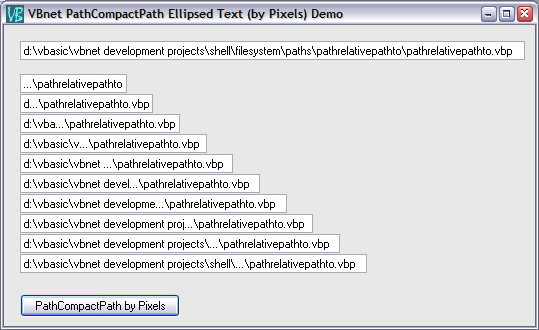
|
|
 |
|
||
|
|
|||
|
||||||||||||||||||||||||||||||||||||||||||||||||||||||||
|
|
||||||||||||||||||||||||||||||||||||||||||||||||||||||||
|
|
||
| Visual Basic File API
Routines PathCompactPath: Adding Ellipses to a File Path |
||
| Posted: | Thursday May 20, 2004 | |
| Updated: | Monday December 26, 2011 | |
| Applies to: | VB4-32, VB5, VB6 | |
| Developed with: | VB6, Windows XP | |
| OS restrictions: | See prerequisites below | |
| Author: | VBnet - Randy Birch | |
| Related: |
DrawText: Add Ellipses to a File Path |
|
| Prerequisites |
|
Version 4.71 and later of Shlwapi.dll. Requires Windows 2000 or later (or Windows NT 4.0 with Internet Explorer 4.0 or later). Requires Windows 98/ME (or Windows 95 with Internet Explorer 4.0 or later). |
|
|
 There
are three methods to adding ellipses to file paths ...
PathCompactPath, PathCompactPathEx and DrawText. There
are three methods to adding ellipses to file paths ...
PathCompactPath, PathCompactPathEx and DrawText.
All three are equally effective, and all three have specific uses. And all three create strings with the ellipses placed at an approximate midpoint inside the string (when possible) to ensure the output string shows both the start and end of the path. DrawText also offers the DT_END_ELLIPSIS flag which forces the ellipses to the end of the string instead. This page shows how to call PathCompactPath to ellipse a common string to a number of different widths, all based on the size of the control. Much of the code below creates the controls and handles the calls to the function ... the actual PathCompactPath call is quite compact - no pun intended. You will note as well that the first ellipsed string in the demo does not show the original string's ".vbp" extension. It's not actually missing - the ellipsed string includes the file extension but the final ellipsed string exceeds the width of the textbox. This is a limitation of the small text box size and demonstrates that it may be possible to obtain unexpected results when the ellipsed string can not be logically broken at a path marker. |
| BAS Module Code |
| None. |
|
|
| Form Code |
|
|
| Add a text box (Text1), a second text box (Text2) with it's Index set to 0 to create a control array, and a command button (Command1) to a form. The code will create the required array of Text2 controls for the demo. Add the following code: |
|
|
Option Explicit '''''''''''''''''''''''''''''''''''''''''''''''''''''''''''''''' ' Copyright ©1996-2011 VBnet/Randy Birch, All Rights Reserved. ' Some pages may also contain other copyrights by the author. '''''''''''''''''''''''''''''''''''''''''''''''''''''''''''''''' ' Distribution: You can freely use this code in your own ' applications, but you may not reproduce ' or publish this code on any web site, ' online service, or distribute as source ' on any media without express permission. '''''''''''''''''''''''''''''''''''''''''''''''''''''''''''''''' Private Const MAX_PATH As Long = 260
Private Declare Function PathCompactPath Lib "shlwapi.dll" _
Alias "PathCompactPathA" _
(ByVal hdc As Long, _
ByVal lpszPath As String, _
ByVal dx As Long) As Long
Private Declare Function lstrlenW Lib "kernel32" _
(ByVal lpString As Long) As Long
Private Sub Form_Load()
Dim cnt As Long
'set up a few text boxes of varying widths
For cnt = 0 To 9
If cnt > 0 Then
Load Text2(cnt)
End If
With Text2(cnt)
.Text = ""
.Left = Text1.Left
.Top = (Text1.Top + Text1.Height) + (210 + (300 * cnt))
.Height = 285
'change the 400 to another value
'to create wider or narrower controls
.Width = 1600 + (cnt * 400)
.Visible = True
End With
Next
With Command1
.Move Text1.Left, Text2(9).Top + 600, 2400, 345
.Caption = "PathCompactPath by Pixels"
End With
'a nice long path
Text1.Text = "d:\vbasic\vbnet development" & _
" projects\shell\filesystem\" & _
"paths\pathrelativepathto\" & _
"pathrelativepathto.vbp"
End Sub
Private Sub Command1_Click()
'Truncate the file path to fit within
'a given pixel width by replacing path
'components with ellipses.
Dim cnt As Long
Dim ctlwidth As Long
Dim buff As String
buff = Text1.Text
For cnt = 0 To 9
'calc the control with and tweak
'a bit smaller to allow for the
'control border and text box white
'space at the left and right of the text
ctlwidth = (Text2(cnt).Width / Screen.TwipsPerPixelX) * 0.96
Text2(cnt).Text = MakeCompactedPathPixels(buff, Me.hdc, ctlwidth)
Next
End Sub
Private Function MakeCompactedPathPixels(ByVal sPath As String, _
dwHdc As Long, _
dwPixels As Long) As String
'Truncates a file path to fit within
'a given pixel width by replacing path
'components with ellipses.
Dim ret As Long
Dim buff As String
'the path to compact and the
'return buffer are the same string
'and must be MAX_PATH in length
buff = sPath & Chr$(0) & Space$(MAX_PATH - Len(sPath) - 1)
ret = PathCompactPath(dwHdc, buff, dwPixels)
MakeCompactedPathPixels = TrimNull(buff)
End Function
Private Function TrimNull(startstr As String) As String
TrimNull = Left$(startstr, lstrlenW(StrPtr(startstr)))
End Function
|
| Comments |
|
|
|
|
|
|||||
|
|||||
|
|
|||||
|
Copyright ©1996-2011 VBnet and Randy Birch. All Rights Reserved. |
 |